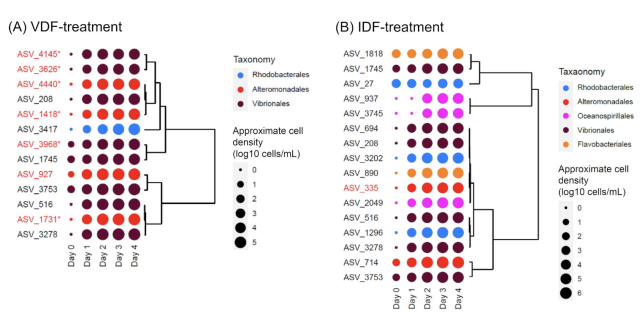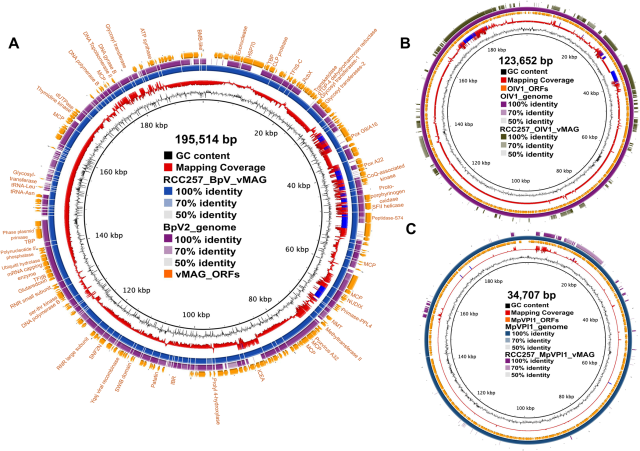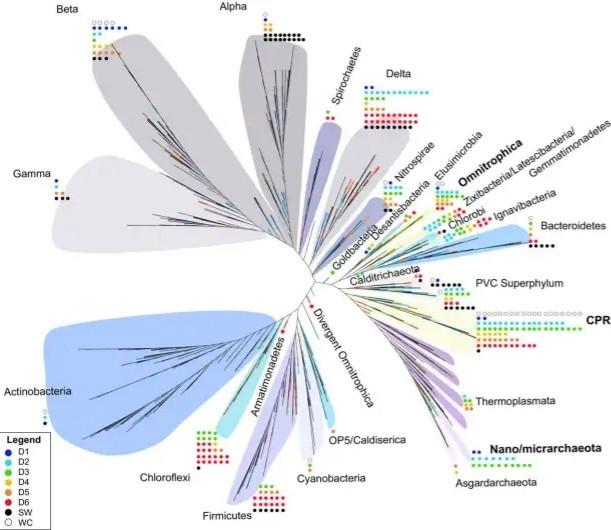Search
Items tagged with: Microbes
Novel research reveals thriving microbial life in trees phys.org/news/2025-08-reveals-…
A diverse and distinct #microbiome inside living trees nature.com/articles/s41586-025…
"A single tree hosts about one trillion #bacteria in its woody tissue... #microbes are partitioned between heartwood and sapwood with each having its own unique microbiomes with minimal similarity to other tissues... They are actively producing gases and cycling nutrients... these communities may have coevolved with #trees over time"
Novel research reveals thriving microbial life in trees
There's a thriving community of diverse microbes living in tree wood, a new study led by a Yale School of the Environment team of scientists has found. A single tree hosts about one trillion bacteria in its woody tissue.Yale University (Phys.org)
Reasons to Hope: Palm Oil Alternatives Made Without Deforestation
The race is on to find a real solution to stop palm oil ecocide. For several years now, several new #biotech companies have been busy generating alternatives to palm oil that are healthier for huma…Palm Oil Detectives
Reasons to Hope: synthetic #palmoil alternatives. These will be free of #deforestation - for real! Made from #algae #yeast #microbes, even CO2! Advocate for deforestation-free #palmoil alternatives #Boycottpalmoil 🌴☠️⛔️ #Boycott4Wildlife
Video and article from our lab about our latest giant virus paper
"Researchers discover large dormant virus can be reactivated in model green alga"
news.vt.edu/articles/2025/04/r…
And link to original paper
science.org/stoken/author-toke…
#viruses #science #virology #microbes

Researchers discover large dormant virus can be reactivated in model green alga
Frank Aylward and Maria Paula Erazo Garcia discovered the largest virus ever recorded with a latent infection cycle in the model green alga Chlamydomonas reinhardti. Their findings were published in Science.news.vt.edu
Advanced genetic techniques and #microscopy offer new insights into anaerobic ciliate and methanogen #symbiosis phys.org/news/2024-10-advanced…
Methanogenic #symbionts of anaerobic #ciliates are host and habitat specific academic.oup.com/ismej/article… #ISEPpapers by @joro
"This study provides a clearer understanding of how anaerobic ciliates have evolved a mix transmission mode to both maintain and replace their symbionts over time"
#microbes #protists #bacteria #archaea #methanogenesis #biology
Advanced genetic techniques and microscopy offer new insights into anaerobic ciliate and methanogen symbiosis
A recent study has uncovered critical details about the association between anaerobic ciliates and methanogenic archaea, a relationship that has fascinated scientists for over decades.Charles University (Phys.org)
New #ISEPpapers! Evolutionary origins of the lysosome-related organelle sorting machinery reveal ancient homology in post-endosome trafficking pathways: Kiran More et al. pnas.org/doi/10.1073/pnas.2403…
#protists #microbes #CellBiology #eukaryogenesis #biology #organelles
New #ISEPpapers #preprint! Viral infection to the raphidophycean alga #Heterosigma akashiwo affects both intracellular organic matter composition and dynamics of a coastal prokaryotic community biorxiv.org/content/10.1101/20…
#protists #algae #viruses #microbes #biology
Viral infection to the raphidophycean alga Heterosigma akashiwo affects both intracellular organic matter composition and dynamics of a coastal prokaryotic community
Marine microalgae play a crucial role in marine ecosystem by supplying dissolved organic matter to heterotrophic prokaryotes, which mediate the microbial loop.bioRxiv
New #ISEPpapers! Updated classification of the phylum Parabasalia onlinelibrary.wiley.com/doi/fu…
"Most are harmless or beneficial gut #symbionts of #animals, but some have turned into #parasites in other body compartments, the most notorious example being #Trichomonas vaginalis in humans."
New #ISEPpapers! Contractile vacuoles: a rapidly expanding (and occasionally diminishing?) understanding sciencedirect.com/science/arti… by Kiran More et al.
#protists #microbes #organelles #biology #evolution #algae #parasites
#Microbes used poison gas in battle for iron in the Earth's early oceans phys.org/news/2024-10-microbes…
Inhibition of phototrophic iron oxidation by nitric oxide in ferruginous environments: Verena Nikeleit et al. nature.com/articles/s41561-024…
"A new study investigates how various #bacteria excrete insoluble iron as part of their metabolic processes. Some—the phototrophic iron oxidizers—gain energy by oxidizing Fe with the help of sunlight, and others by reacting Fe with nitrate as an oxidizing agent."
Some microbes used poison gas in battle for iron in the Earth's early oceans, geomicrobiologists find
Early in the Earth's development, the atmosphere contained no oxygen. Yet the iron dissolved in the oceans was oxidized in gigantic quantities and deposited as rock. It can be seen today, for example, as banded iron ore in South Africa.University of Tübingen (Phys.org)
The Last Universal Common Ancestor of Ribosome-Encoding Organisms: Portrait of LUCA
link.springer.com/article/10.1…
#evolution #microbiology #science #microbes

The Last Universal Common Ancestor of Ribosome-Encoding Organisms: Portrait of LUCA - Journal of Molecular Evolution
The existence of LUCA in the distant past is the logical consequence of the binary mechanism of cell division.SpringerLink
Genomic analyses of Symbiomonas scintillans show no evidence for endosymbiotic bacteria but does reveal the presence of giant viruses
Author summary Endosymbiotic bacteria are found in a wide variety of hosts across the tree of eukaryotes and have been proposed to be evolutionarily and ecologically significant, but in most cases, we know little to nothing about them.journals.plos.org
New #ISEPpapers #preprint! Comprehensive analysis of the microbial consortium in the culture of flagellate #Monocercomonoides exilis biorxiv.org/content/10.1101/20… #protists #microbes #mitochondria #bacteria #biorxiv @biorxivpreprint
"Monocercomonoides exilis is the only known amitochondriate eukaryote, making it an excellent model for studying the implications of mitochondrial reduction from a cellular and evolutionary point of view."
Comprehensive analysis of the microbial consortium in the culture of flagellate Monocercomonoides exilis
Monocercomonoides exilis is the only known amitochondriate eukaryote, making it an excellent model for studying the implications of mitochondrial reduction from a cellular and evolutionary point of view. Although M.bioRxiv
Follow the leader: A new study of #flagella in #algae reveals how they coordinate their movements to ensure cells steer efficiently elifesciences.org/digests/8610… #protists #microbes
The younger flagellum sets the beat for #Chlamydomonas reinhardtii elifesciences.org/articles/861…
"To steer, C. reinhardtii adjusts the strength of the strokes made by each flagellum. Despite this asymmetry, the flagella must continue to beat in synchrony to move efficiently."
The younger flagellum sets the beat for Chlamydomonas reinhardtii
External hydrodynamic forcing on each flagellum of Chlamydomonas reinhardtii reveals a leader-follower relation between the two flagella in the synchronous beating.Da Wei (eLife Sciences Publications, Ltd)
Mesmerising microbes: bacteria as you’ve never seen it before – in pictures
“As a side hustle he manipulates and photographs the microbial world; his images are collected in a book, Beautiful Bacteria. Taking bacteria from substances such as wastewater, dental plaque or kimchi, Danino lets them multiply in a petri dish, adding dyes. The results are artworks differing from the digital enhancements often made in scientific photography to make images more informative.”
theguardian.com/artanddesign/g…
#News #Photography #Photo #Photos #Image #Images #Microbiology #Biology #Science #STEM #Bacteria #Microbes #Microbes @science @biology @microbiology

Mesmerising microbes: bacteria as you’ve never seen it before – in pictures
Scientist Tal Danino’s incredible images of the microbial worldThe Guardian
#Mutualism on the edge: Understanding the #Paramecium–#Chlorella symbiosis journals.plos.org/plosbiology/…
"Exploring the mechanisms that underpin #symbiosis requires an understanding of how these complex interactions are maintained in diverse model systems. The ciliate #protist, Paramecium bursaria, offers a valuable insight into how emergent endosymbiotic interactions have evolved."
#protists #algae #microbes #ciliates
Mutualism on the edge: Understanding the Paramecium–Chlorella symbiosis
Exploring the mechanisms that underpin symbiosis requires an understanding of how these complex interactions are maintained in diverse model systems.journals.plos.org
Minimalist or maximalist? The life of a #microbe a mile underground
phys.org/news/2023-11-minimali… paper: ami-journals.onlinelibrary.wil…
Magdalena Osburn: "The deep subsurface #biosphere is enormous; it's just a vast amount of space... Many of the #microbes we found were either minimalist: ultra-streamlined with one job that it does very well alongside a close consortium of collaborators, or it can do a little bit of everything. These maximalists are ready for every resource that comes along."
Minimalist or maximalist? The life of a microbe a mile underground
If you added up all the microbes living deep below Earth's surface, the amount of biomass would outweigh all life within our oceans.Amanda Morris (Phys.org)
New #ISEPpapers! The #protist #Aurantiochytrium has universal subtelomeric rDNAs and is a host for #mirusviruses: Jackie Collier et al. cell.com/current-biology/fullt…
#protists #microbes #protistology #microbiology #viruses #virology #genomics
Long-read-based genome assembly reveals numerous endogenous viral elements in the green algal bacterivore Cymbomonas tetramitiformis
Abstract. The marine tetraflagellate Cymbomonas tetramitiformis has drawn attention as an early diverging green alga that uses a phago-mixotrophic mode of nutriGyaltshen, Yangtsho (Oxford University Press)
Encyclopaedia of DNA polymerases localized in organelles: Evolutionary contribution of diverse bacteria including the proto-mitochondrion
DNA polymerases (DNAPs) synthesize DNA from deoxyribonucleotides in a semi-conservative manner and serve as the core of DNA replication and repair machineries.bioRxiv
Endless microbes most beautiful and most wonderful
"To reflect the importance of microbes and to create a home for microbiology research using genetics, PLOS Genetics will be launching a new section on Microbial Genetics. "
As we (humans) get to grips with how to scale up #hydrogen as an energy source (and for energy storage) and as part replacement for #fossilfuels, this new research (once again) shows that #microbes have beaten us to it and evolved their own solutions for energy - in this case using hydrogen power.
This new research in Nature Microbiology explores how hydrogen in seawater supports growth of multiple and diverse #bacterial species.
Fof those (like me) in #Melbourne , you may be interested that the research also includes study of this process within #PortPhillipBay sediments.
Learn more on:
nature.com/articles/s41564-023…
#microbiology #bacteria #ecology #MicrobialEcology
Molecular hydrogen in seawater supports growth of diverse marine bacteria - Nature Microbiology
Genome-resolved metagenomics, biogeochemistry, modelling and culture-based analysis reveal that marine bacteria consume H2 to support growth.Nature
Rare opportunity to study short-lived volcanic island reveals sulfur-metabolizing #microbes phys.org/news/2023-01-rare-opp…
The Early Microbial Colonizers of a Short-Lived Volcanic Island in the Kingdom of #Tonga journals.asm.org/doi/10.1128/m…
"We didn't see what we were expecting. We thought we'd see organisms you find when a glacier retreats, or #cyanobacteria, more typical early colonizer species—but instead we found a unique group of #bacteria that metabolize sulfur and atmospheric gases."
Rare opportunity to study short-lived volcanic island reveals sulfur-metabolizing microbes
In 2015, a submarine volcano in the South Pacific erupted, forming the Hunga Tonga Hunga Ha'apai island, destined to a short, seven-year life.Science X (Phys.org)



























